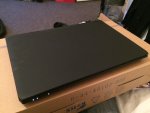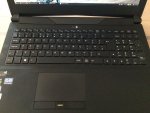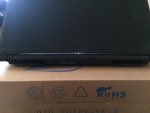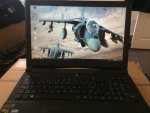Specs
CPU: Intel Core i5-6440HQ @ 2.6 GHz (3.5 GHz turbo)
RAM: 8GB Kingston SODIMM DDR3 1600MHz
GPU: NVIDIA GTX 965M (+ Intel HD 530)
Storage: WD Black 750GB WD7500BPKX HDD, 128GB M.2 2280 SSD
Shopping experience
Owning a custom desktop PC that I built I know as well as anyone the joys of having a machine that is built with me in mind, and not for the mass market. Customising the machine was a surprisingly enjoyable task, though naturally the thing that sealed the deal was the ability to not have Windows preinstalled, thus saving me a full £80 on the marked price. I'm primarily a Linux user but I have free Windows licenses from uni so it would be foolish to purchase another.
Of course, when purchasing the webpage gave me a warning regarding hardware compatibility on Linux. It threw me a little, but I wasn't really fussed. In this day and age you can sue someone for creasing your shirt the wrong way (and a lot of people will!). If you're planning to use Linux on a PC Specialist machine, take this more as "We can't guarantee the hardware will work properly in Linux, YMMV" and not "You naughty Linux user, use Windows 10, it's glorious in its proprietaryness and user-babying". They just have to cover their backsides just in case some idiot tries to sue them because "they weren't explicitly told" that the Skylake processor would cause his obscure Linux distribution running on a very old kernel to explode. Of course it did, you fool.
Admittedly the warning could have used a little less red text.
Build time
Because I was replacing an old machine that had given up I needed it quickly, so I went for the 5-day dispatch option as the 3-day one was a little too pricey considering the total price of the machine (about £720). This was done shortly after noon on a Monday (7th March) so the first working day was considered to be the Tuesday.
I was, in all honesty, overjoyed with the build time. It passed through pre-production and build on Tuesday 8th, was tested on the 9th, and passed through QA and dispatch on the 10th, arriving on Friday 11th. I wasn't expecting it until the following Tuesday! Essentially got the 3-day service for the price of the 5-day one. When I saw that it had reached Awaiting Dispatch I switched from standard delivery to pre 10:30 because I was going out the next day. This change was done very quickly and did not cause any delays to the dispatch, which I was relieved to see.
First impressions
I was quite surprised as stated above when DPD arrived on my doorstep, and even more surprised when I saw the size of the box. You could easily get a full-size ATX desktop PC in there! Inside was a more reasonably-sized box containing the machine and the usual gubbins, along with a lot of padding. These guys certainly take pains to ensure their product reaches you undamaged.
The laptop box is a standard affair - I've unboxed dozens of laptops in my part-time job and hence knew what to expect - laptop in a plastic sleeve, encased in protective foam, etc.
Form
The casing is a standard Clevo job, and overall feels very sturdy. You can see the appearance of the machine in photos on the website, but the machine has a certain presence to it, if you catch my drift. It doesn't stand out in the slightest, the casing is devoid of any pointless OEM logos and is an utterly nondescript matte black. I love it for that.

Open the lid, however, and just from the positioning and angular shape of the speakers and power button you get a hint of the beast that lies inside. A subtle hint, mind, it doesn't shout about its performance.

Look to the back and you see two large, angular air vents alongside the hinges, along with multiple vents underneath.

Think of a BMW M3, and set it next to, say, a Gumpert Apollo (performance differences notwithstanding). The Gumpert is a gaming laptop, with angles and winglets, the BMW is this. Sleek, with subtle hints to the power underneath.
The machine itself is a little on the heavy side which complements its sturdy feel, especially when compared to cheaper, flimsier OEM machines, the HP ones most notably. But not so heavy that carrying it around for lengthy periods is uncomfortable, so it's still OK there.
One thing to note if you are getting one of these - the casing seems to be a bit of a fingerprint magnet. This is most easily demonstrated on the lid and the topcase area around and in front of the keyboard. Not really much of a concern, however.
Connectivity
The ports afforded to you are slightly more than your average 15.6" laptop. On the left side you get 2 USB 3.0 ports, a 3-way audio in/out interface and the optional optical drive. On the right there are two memory card slots, another USB 3.0 port, a VGA-out and an ethernet port. On the back you have the DC port, what looks to be a mini DisplayPort, an HDMI port and ANOTHER USB 3.0 port. This wide selection is not really of any consequence to me, but having options is never a disadvantage.
Keyboard and touchpad
Aside from the innards, these two parts have to be my favourite aspects of this machine. I've always hated laptop inputs, both the touchpads and the keyboards. The touchpads I find to have a nasty feel about them, especially the ones with built-in buttons (seriously?), the keyboards too small and tacky in general.
But not this one. The keyboard on this machine is a great size, feels solid and the keys have a springy feedback I've never seen in a laptop before, and speedtyping is a breeze. Coming from someone who is used to Logitech's Romer-G mechanical switches (which allegedly are similar to Cherry Reds) I have to say I adore this keyboard. My only niggle is that the right shift key could really be a tiny bit longer, it can sometimes be easy to hit the up arrow instead of the shift key when typing, but that really varies from person to person. It's certainly bigger than the Lenovo AccuType, in any case, and that is a keyboard I absolutely despise.
The touchpad is of similar quality. The "mouse" area itself is pleasantly large, and the two left and right buttons are not only separate from both each other and the touchpad, but they seem to have the same feel and travel distance as the keyboard, making a click using a buttons an annoyingly satisfying thing to do. Why can't all laptop touchpads be like this?
Performance
The specs say it all, really.
In Windows, the NVIDIA Optimus drivers work perfectly. The machine is as quiet as they come when running off the Intel integrated chip. However, start stressing it and the NVIDIA GPU will switch on, take over graphics processing accompanied by a sound not too unlike a jet engine as the fans kick in to keep it cool, which is normal for laptops with mobile GPUs.
In Linux, not so much, but we'll get onto that later, as that is not a fault of the machine itself.
Battery life is decidedly average from what I've seen, though I rarely use the Windows installation so I cannot comment too much on it, but it looks like around 5-6 hours or so. Needless to say that is running on the Intel GPU, on the NVIDIA one it would obviously be much less.
Linux!
I currently have Windows 10 running off the HDD, along with Linux straddling both storage devices - / and /boot on the SSD and /home on the HDD.
Getting Linux working was, as is to be expected on newer hardware, a bit of a ballache. The distro in question here is Mint 17.3 running the Cinnamon desktop.
The wifi hardware does not work on the kernel that is installed with the live image (3.19 I believe), but hook it up to an ethernet cable and update the kernel to 4.x and it will work.
In my case, this caused various issues with the Cinnamon desktop, which, through the great community over at the Linux Mint forums, we found to be caused by the Skylake architecture being rather new. This was fixed by adding a line in /etc/default/grub which enabled preliminary support for the new chipset.
Be warned regarding NVIDIA Optimus, though. NVIDIA's own drivers are pretty shocking, to say the least, when it comes to Optimus support on Linux. Unlike in Windows where the NVIDIA GPU switches on automatically, with nvidia-settings you have to switch the GPU manually, which also requires restarting the desktop (just logout/in). Even then, when running off the Intel GPU the machine seems to run rather hot and I can hear the fans running while doing non-intensive tasks. I suspect the NVIDIA GPU is not actually turned off in this instance, rather unused, but I'm still investigating this to find the actual cause, again with the help of the Mint community.
Again, a fault of NVIDIA's drivers, not the machine. It's just worth a mention for those looking to install Linux on one of these. Don't take it as a knock against PC Specialist, I'm rather certain that all Optimus systems have this issue in Linux, along with whatever the AMD equivalent is. Blame NVIDIA.

In short, this is a great machine for programming, general use and gaming as well. It looks great, feels great and performs brilliantly. Buy it, you won't regret it.
CPU: Intel Core i5-6440HQ @ 2.6 GHz (3.5 GHz turbo)
RAM: 8GB Kingston SODIMM DDR3 1600MHz
GPU: NVIDIA GTX 965M (+ Intel HD 530)
Storage: WD Black 750GB WD7500BPKX HDD, 128GB M.2 2280 SSD
Shopping experience
Owning a custom desktop PC that I built I know as well as anyone the joys of having a machine that is built with me in mind, and not for the mass market. Customising the machine was a surprisingly enjoyable task, though naturally the thing that sealed the deal was the ability to not have Windows preinstalled, thus saving me a full £80 on the marked price. I'm primarily a Linux user but I have free Windows licenses from uni so it would be foolish to purchase another.
Of course, when purchasing the webpage gave me a warning regarding hardware compatibility on Linux. It threw me a little, but I wasn't really fussed. In this day and age you can sue someone for creasing your shirt the wrong way (and a lot of people will!). If you're planning to use Linux on a PC Specialist machine, take this more as "We can't guarantee the hardware will work properly in Linux, YMMV" and not "You naughty Linux user, use Windows 10, it's glorious in its proprietaryness and user-babying". They just have to cover their backsides just in case some idiot tries to sue them because "they weren't explicitly told" that the Skylake processor would cause his obscure Linux distribution running on a very old kernel to explode. Of course it did, you fool.
Admittedly the warning could have used a little less red text.
Build time
Because I was replacing an old machine that had given up I needed it quickly, so I went for the 5-day dispatch option as the 3-day one was a little too pricey considering the total price of the machine (about £720). This was done shortly after noon on a Monday (7th March) so the first working day was considered to be the Tuesday.
I was, in all honesty, overjoyed with the build time. It passed through pre-production and build on Tuesday 8th, was tested on the 9th, and passed through QA and dispatch on the 10th, arriving on Friday 11th. I wasn't expecting it until the following Tuesday! Essentially got the 3-day service for the price of the 5-day one. When I saw that it had reached Awaiting Dispatch I switched from standard delivery to pre 10:30 because I was going out the next day. This change was done very quickly and did not cause any delays to the dispatch, which I was relieved to see.
First impressions
I was quite surprised as stated above when DPD arrived on my doorstep, and even more surprised when I saw the size of the box. You could easily get a full-size ATX desktop PC in there! Inside was a more reasonably-sized box containing the machine and the usual gubbins, along with a lot of padding. These guys certainly take pains to ensure their product reaches you undamaged.
The laptop box is a standard affair - I've unboxed dozens of laptops in my part-time job and hence knew what to expect - laptop in a plastic sleeve, encased in protective foam, etc.
Form
The casing is a standard Clevo job, and overall feels very sturdy. You can see the appearance of the machine in photos on the website, but the machine has a certain presence to it, if you catch my drift. It doesn't stand out in the slightest, the casing is devoid of any pointless OEM logos and is an utterly nondescript matte black. I love it for that.

Open the lid, however, and just from the positioning and angular shape of the speakers and power button you get a hint of the beast that lies inside. A subtle hint, mind, it doesn't shout about its performance.

Look to the back and you see two large, angular air vents alongside the hinges, along with multiple vents underneath.

Think of a BMW M3, and set it next to, say, a Gumpert Apollo (performance differences notwithstanding). The Gumpert is a gaming laptop, with angles and winglets, the BMW is this. Sleek, with subtle hints to the power underneath.
The machine itself is a little on the heavy side which complements its sturdy feel, especially when compared to cheaper, flimsier OEM machines, the HP ones most notably. But not so heavy that carrying it around for lengthy periods is uncomfortable, so it's still OK there.
One thing to note if you are getting one of these - the casing seems to be a bit of a fingerprint magnet. This is most easily demonstrated on the lid and the topcase area around and in front of the keyboard. Not really much of a concern, however.
Connectivity
The ports afforded to you are slightly more than your average 15.6" laptop. On the left side you get 2 USB 3.0 ports, a 3-way audio in/out interface and the optional optical drive. On the right there are two memory card slots, another USB 3.0 port, a VGA-out and an ethernet port. On the back you have the DC port, what looks to be a mini DisplayPort, an HDMI port and ANOTHER USB 3.0 port. This wide selection is not really of any consequence to me, but having options is never a disadvantage.
Keyboard and touchpad
Aside from the innards, these two parts have to be my favourite aspects of this machine. I've always hated laptop inputs, both the touchpads and the keyboards. The touchpads I find to have a nasty feel about them, especially the ones with built-in buttons (seriously?), the keyboards too small and tacky in general.
But not this one. The keyboard on this machine is a great size, feels solid and the keys have a springy feedback I've never seen in a laptop before, and speedtyping is a breeze. Coming from someone who is used to Logitech's Romer-G mechanical switches (which allegedly are similar to Cherry Reds) I have to say I adore this keyboard. My only niggle is that the right shift key could really be a tiny bit longer, it can sometimes be easy to hit the up arrow instead of the shift key when typing, but that really varies from person to person. It's certainly bigger than the Lenovo AccuType, in any case, and that is a keyboard I absolutely despise.
The touchpad is of similar quality. The "mouse" area itself is pleasantly large, and the two left and right buttons are not only separate from both each other and the touchpad, but they seem to have the same feel and travel distance as the keyboard, making a click using a buttons an annoyingly satisfying thing to do. Why can't all laptop touchpads be like this?
Performance
The specs say it all, really.
In Windows, the NVIDIA Optimus drivers work perfectly. The machine is as quiet as they come when running off the Intel integrated chip. However, start stressing it and the NVIDIA GPU will switch on, take over graphics processing accompanied by a sound not too unlike a jet engine as the fans kick in to keep it cool, which is normal for laptops with mobile GPUs.
In Linux, not so much, but we'll get onto that later, as that is not a fault of the machine itself.
Battery life is decidedly average from what I've seen, though I rarely use the Windows installation so I cannot comment too much on it, but it looks like around 5-6 hours or so. Needless to say that is running on the Intel GPU, on the NVIDIA one it would obviously be much less.
Linux!
I currently have Windows 10 running off the HDD, along with Linux straddling both storage devices - / and /boot on the SSD and /home on the HDD.
Getting Linux working was, as is to be expected on newer hardware, a bit of a ballache. The distro in question here is Mint 17.3 running the Cinnamon desktop.
The wifi hardware does not work on the kernel that is installed with the live image (3.19 I believe), but hook it up to an ethernet cable and update the kernel to 4.x and it will work.
In my case, this caused various issues with the Cinnamon desktop, which, through the great community over at the Linux Mint forums, we found to be caused by the Skylake architecture being rather new. This was fixed by adding a line in /etc/default/grub which enabled preliminary support for the new chipset.
Be warned regarding NVIDIA Optimus, though. NVIDIA's own drivers are pretty shocking, to say the least, when it comes to Optimus support on Linux. Unlike in Windows where the NVIDIA GPU switches on automatically, with nvidia-settings you have to switch the GPU manually, which also requires restarting the desktop (just logout/in). Even then, when running off the Intel GPU the machine seems to run rather hot and I can hear the fans running while doing non-intensive tasks. I suspect the NVIDIA GPU is not actually turned off in this instance, rather unused, but I'm still investigating this to find the actual cause, again with the help of the Mint community.
Again, a fault of NVIDIA's drivers, not the machine. It's just worth a mention for those looking to install Linux on one of these. Don't take it as a knock against PC Specialist, I'm rather certain that all Optimus systems have this issue in Linux, along with whatever the AMD equivalent is. Blame NVIDIA.

In short, this is a great machine for programming, general use and gaming as well. It looks great, feels great and performs brilliantly. Buy it, you won't regret it.
